Neurology for the Non-Neurologist, 6th Edition
| Neurology for the Non-Neurologist, Sixth Edition is a practical guide for primary care physicians, psychiatrists, and other non-neurologist clinicians who encounter patients with neurologic problems. The book begins with overviews of neurologic symptoms, the neurologic examination, diagnostic tests, and neuroradiology, and then covers the full range of neurologic disorders that non-neurologists encounter. Chapters follow a consistent structure with key elements highlighted for quick scanning. Each chapter begins with Key Points and includes Special Clinical Points interspersed with the text to focus readers on the most crucial details. The authors alert readers to Special Considerations in the Hospitalized Patient and When a Non-neurologist Should Consider Referring to a Neurologist. Each chapter ends with an Always Remember section emphasizing the most important practical issues and a series of self-study questions. | |||
Table of contents : Cover......Page 1 Title Page......Page 3 Copyright......Page 4 Dedication......Page 5 Contents......Page 6 Contributors......Page 8 Preface......Page 11 Acknowledgments......Page 13 MENTAL STATUS AND COGNITION......Page 15 Speech and Language......Page 16 Executive Function......Page 17 Mini-Mental Status Examination (MMSE)......Page 18 CRANIAL NERVES......Page 19 CN II. The Optic Nerve......Page 20 CN V. The Trigeminal Nerve......Page 21 CN VIII. The Vestibulocochlear Nerve......Page 22 CN XII. Hypoglossal Nerve......Page 23 MOTOR EXAMINATION......Page 24 DEEP TENDON REFLEXES (DTRs)......Page 25 SENSORY TESTING......Page 26 COORDINATION AND GAIT......Page 28 Mental Status......Page 29 Coordination......Page 30 QUESTIONS AND DISCUSSION......Page 31 SUGGESTED READING......Page 32 COMMON NEUROLOGIC TERMS......Page 34 MENTAL STATUS CHANGES......Page 35 WEAKNESS......Page 36 Upper Motor Neuron Lesions......Page 37 Lower Motor Neuron Lesions......Page 38 PAIN AND SENSORY SYNDROMES......Page 39 GAIT DISORDERS......Page 41 ROLE OF THE TEMPORAL COURSE OF NEUROLOGIC ILLNESS IN NEUROLOGIC DIAGNOSIS......Page 42 QUESTIONS AND DISCUSSION......Page 43 SUGGESTED READING......Page 46 INTRODUCTION......Page 47 Computed Tomography (CT)......Page 48 Myelography......Page 49 Catheter Angiography......Page 50 Electromyography (EMG)......Page 51 Lumbar Puncture......Page 52 Tissue Biopsy......Page 53 QUESTIONS AND DISCUSSION......Page 55 SUGGESTED READING......Page 56 CHAPTER 4: Fundamentals of Neuroradiology......Page 57 COMPUTED TOMOGRAPHY VERSUS MAGNETIC RESONANCE IMAGING......Page 58 CONTRAST VERSUS NONCONTRAST......Page 60 HERNIATION AND MASS EFFECT......Page 61 HYDROCEPHALUS VERSUS VOLUME LOSS......Page 63 CYTOTOXIC VERSUS VASOGENIC EDEMA......Page 64 INTRA-AXIAL VERSUS EXTRA-AXIAL......Page 65 INTRACRANIAL HEMORRHAGE......Page 67 INFARCT EVALUATION AND VASCULAR IMAGING......Page 70 CONCLUSION......Page 74 QUESTIONS AND DISCUSSION......Page 75 SUGGESTED READING......Page 76 Status Epilepticus......Page 77 Treatment of SE......Page 79 ACUTE ALTERATION OF MENTAL STATUS......Page 83 Treatment of Delirium......Page 87 ACUTE INTRACRANIAL HYPERTENSION......Page 88 Treatment of Acute Intracranial Hypertension......Page 90 ACUTE SPINAL CORD COMPRESSION......Page 91 Treatment of Acute Spinal Cord Compression......Page 92 Myasthenic Crisis......Page 93 Treatment of Myasthenic Crisis......Page 94 GUILLAIN–BARRÉ SYNDROME......Page 95 Treatment of Guillain–Barré Syndrome......Page 96 NEUROLEPTIC MALIGNANT SYNDROME......Page 97 Treatment of Neuroleptic Malignant Syndrome......Page 98 QUESTIONS AND DISCUSSION......Page 100 SUGGESTED READING......Page 101 CHAPTER 6: Examination of the Comatose Patient......Page 103 DEFINITIONS AND CLINICAL SYNDROMES......Page 104 ETIOLOGY......Page 105 HISTORY AND EXAMINATION......Page 107 LABORATORY EVALUATION AND TREATMENT......Page 113 WHEN TO REFER THE PATIENT TO A NEUROLOGIST......Page 116 QUESTIONS AND DISCUSSION......Page 117 SUGGESTED READING......Page 118 CHAPTER 7: Cerebrovascular Disease......Page 119 IDENTIFICATION OF THE STROKE-PRONE INDIVIDUAL......Page 120 CLINICAL EVALUATION......Page 122 DIAGNOSTIC EVALUATION......Page 124 Presentation and Localization......Page 127 OPTIMIZATION OF ISCHEMIC STROKE PREVENTION......Page 128 ACUTE ISCHEMIC STROKE INTERVENTION......Page 129 Clinical Approach......Page 131 Treatment......Page 132 Intracranial Aneurysm......Page 134 Arteriovenous Malformation......Page 135 SPECIAL CHALLENGES FOR HOSPITALIZED PATIENTS......Page 136 QUESTIONS AND DISCUSSION......Page 137 SUGGESTED READING......Page 139 INTRODUCTION......Page 141 MIGRAINE......Page 142 TENSION-TYPE HEADACHE......Page 143 MEDICATION OVERUSE HEADACHE (FORMERLY CALLED REBOUND HEADACHE)......Page 144 CLUSTER HEADACHE AND ITS VARIANTS......Page 145 Nonpharmacologic Treatments for Primary Headaches......Page 146 Treatment of MOH......Page 147 Acute Treatment of Migraine......Page 148 Preventive Treatment of Migraine......Page 149 Treatment of Cluster Headache......Page 150 DIAGNOSTIC TESTING AND SECONDARY HEADACHE DISORDERS......Page 151 Hospitalization......Page 152 When and When Not to Administer Opioids......Page 153 QUESTIONS AND DISCUSSION......Page 154 SUGGESTED READING......Page 155 TYPES OF SEIZURES......Page 157 EPILEPSY SYNDROMES......Page 158 DIAGNOSING EPILEPSY......Page 161 MANAGEMENT OF EPILEPSY......Page 162 SERUM ANTIEPILEPTIC DRUG LEVELS......Page 164 SOME INDIVIDUAL ANTIEPILEPTIC DRUGS......Page 165 SURGICAL THERAPIES......Page 166 SPECIAL CHALLENGES FOR MANAGING HOSPITALIZED PATIENTS......Page 167 QUESTIONS AND DISCUSSION......Page 168 SUGGESTED READING......Page 169 CHAPTER 10: Sleep Disorders......Page 170 SLEEP ARCHITECTURE......Page 171 SLEEP DISORDERS ASSOCIATED WITH INSOMNIA......Page 173 SLEEP-ONSET DELAY......Page 174 Treatment......Page 175 Precautions......Page 179 Alternative Therapies......Page 180 RESTLESS LEGS SYNDROME......Page 181 Alternative Treatments......Page 182 EARLY MORNING AWAKENING......Page 184 SPECIAL CHALLENGES FOR HOSPITALIZED PATIENTS......Page 185 SLEEP APNEA......Page 186 EVALUATION OF SUSPECTED SLEEP APNEA......Page 189 Treatment of Sleep Apnea......Page 190 NARCOLEPSY......Page 193 Treatment of Narcolepsy......Page 194 INSUFFICIENT SLEEP......Page 197 PARASOMNIAS......Page 198 When to Refer the Patient with Parasomnia to the Sleep Specialist......Page 200 QUESTIONS AND DISCUSSION......Page 201 SUGGESTED READING......Page 204 HISTORY......Page 206 PATHOLOGY OF MULTIPLE SCLEROSIS......Page 207 Pathologic Correlations with Magnetic Resonance Imaging......Page 209 Immunology of Multiple Sclerosis......Page 210 Relapsing–Remitting Multiple Sclerosis......Page 211 Progressive-Relapsing Multiple Sclerosis......Page 212 Neuromyelitis Optica......Page 213 Optic Neuritis......Page 214 Cerebellar Signs......Page 216 Bladder, Bowel, and Sexual Dysfunction......Page 217 Important Radiologic and Laboratory Features......Page 218 CSF Analysis......Page 220 Errors in Diagnosing Multiple Sclerosis......Page 222 Disease-Modifying Therapies......Page 223 Initiation of Early Therapy......Page 226 Symptomatic Therapy......Page 227 Remyelination and Neuroprotection......Page 232 QUESTIONS AND DISCUSSION......Page 233 SUGGESTED READING......Page 234 CLINICAL FEATURES......Page 236 MECHANISMS OF DISEASE......Page 240 TREATMENT......Page 242 COMPLICATIONS......Page 244 DRUG-INDUCED PARKINSONISM......Page 247 FURTHER CONSIDERATIONS......Page 248 COMPLEMENTARY THERAPIES......Page 249 SPECIAL CHALLENGES FOR HOSPITALIZED PATIENTS......Page 250 QUESTIONS AND DISCUSSION......Page 251 SUGGESTED READING......Page 254 CHAPTER 13: Hyperkinetic Movement Disorders......Page 255 DYSTONIA......Page 256 Classification......Page 258 Pathology and Neurochemistry......Page 265 Treatment......Page 266 Clinical Features......Page 268 Differential Diagnosis......Page 270 Treatment......Page 271 When to Refer to a Neurologist......Page 273 Clinical Features......Page 274 Genetics......Page 275 Pathology, Neurochemistry, and Pathogenesis......Page 277 Treatment......Page 279 Clinical Manifestations......Page 280 Pathogenesis and Genetics......Page 282 Diagnosis......Page 283 Treatment......Page 284 GILLES DE LA TOURETTE SYNDROME......Page 287 Associated Behavioral Disturbances......Page 288 Genetics and Pathophysiology......Page 289 Treatment......Page 290 Clinical Features......Page 293 Pathophysiology......Page 294 Prevention......Page 295 Treatment......Page 296 QUESTIONS AND DISCUSSION......Page 298 SUGGESTED READING......Page 299 OVERVIEW......Page 301 DEMENTIA......Page 302 Differential Diagnosis for Conditions Presenting with Cognitive Impairment......Page 303 Differential Diagnosis of Primary Neurodegenerative Dementias......Page 305 Prion Diseases......Page 311 Pharmacotherapy......Page 312 Other Interventions......Page 315 Special Considerations for Hospitalized Patients......Page 316 QUESTIONS AND DISCUSSION......Page 317 SUGGESTED READING......Page 318 CHAPTER 15: Behavioral Neurology......Page 321 ANATOMIC BASIS—PAPEZ CIRCUIT......Page 322 TEMPORAL LOBE EPILEPSY......Page 323 ANATOMY AND CLINICAL FINDINGS......Page 325 When to Refer Patients to a Neurologist......Page 326 FLUENT APHASIA......Page 327 ETIOLOGY......Page 328 WERNICKE–KORSAKOFF SYNDROME (WERNICKE ENCEPHALOPATHY)......Page 329 ANATOMIC BASIS......Page 330 TRANSIENT GLOBAL AMNESIA......Page 331 Treatment......Page 332 HERPES SIMPLEX ENCEPHALITIS......Page 333 Future Perspectives......Page 334 QUESTIONS AND DISCUSSION......Page 335 SUGGESTED READING......Page 336 EPIDEMIOLOGY AND OVERVIEW......Page 338 PATHOPHYSIOLOGY AND OPERATIONAL TERMS......Page 339 ACUTE HOSPITALIZATION......Page 344 POSTACUTE HOSPITALIZATION......Page 345 Sleep–Wake Cycle Disturbance (SWCD)......Page 346 Late-Onset Hydrocephalus......Page 349 Agitation......Page 350 Mild TBI......Page 352 Neuropsychologic Testing......Page 354 QUESTIONS AND DISCUSSION......Page 355 SUGGESTED READING......Page 357 Weakness......Page 358 Atrophy and Hypertrophy......Page 366 Muscle Twitching......Page 367 Enzyme Elevation......Page 368 Electrodiagnostic Studies......Page 369 SPECIFIC NEUROMUSCULAR DISORDERS......Page 371 Motor Neuron Diseases......Page 372 Disorders of the Neuromuscular Junction......Page 373 Myopathies......Page 375 Special Considerations in Children......Page 381 Special Outpatient Problems in Adults......Page 382 Specific Issues in Other Neuromuscular Disorders......Page 383 Rhabdomyolysis and Myoglobinuria......Page 384 WHEN TO REFER TO A NEUROLOGIST......Page 385 QUESTIONS AND DISCUSSION......Page 386 SUGGESTED READING......Page 388 CLINICAL FEATURES AND SCIENTIFIC BACKGROUND......Page 389 ANATOMY......Page 390 ANATOMIC DISTRIBUTION......Page 391 PATTERNS OF ABNORMALITY......Page 394 PATHOLOGY......Page 395 DIAGNOSIS......Page 396 Management......Page 401 GUILLAIN–BARRÉ SYNDROME......Page 403 NEUROPATHIES ASSOCIATED WITH DIABETES MELLITUS......Page 404 Ulnar Neuropathy......Page 406 FUTURE PERSPECTIVES......Page 407 QUESTIONS AND DISCUSSION......Page 408 SUGGESTED READING......Page 410 ANATOMY......Page 412 Disc Herniation......Page 414 Neurogenic Pain......Page 415 Referred Pain from Abdominal or Pelvic Structures......Page 416 Neurologic Exam......Page 417 WORKUP......Page 418 MRI Spine with Gadolinium......Page 419 Treatment of Acute Low Back Pain ( |














